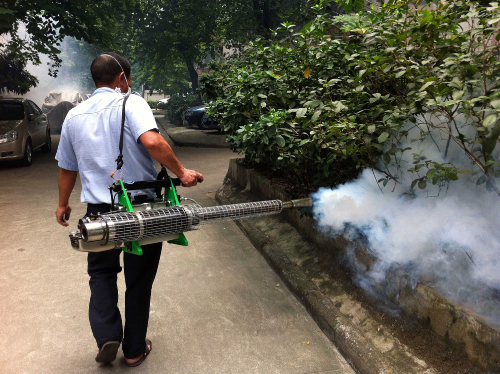 |
|
BATTLING AGAINST MOSQUITOES: A worker sprays pesticide to kill mosquitoes in the Yuexiu Park in Guangzhou, Guangdong Province (XINHUA) |
South China is suffering from its worst outbreak of dengue fever in two decades, with 1,000 new cases of the potentially fatal mosquito-borne disease emerging each day, according to local media reports.
In Guangdong Province alone, the total number of dengue fever cases had reached 42,856 by November 1, according to the provincial health and family planning commission. The disease has been detected in 20 out of 21 prefecture-level cities in the province and six people have died from the virus, according to the commission.
Even worse, another 22 areas including Zhejiang, Fujian, Yunnan provinces and Guangxi Zhuang Autonomous Region have also detected dengue cases numbering into the hundreds this year, according to the National Health and Family Planning Commission (NHFPC).
"The outbreak of dengue fever this year is the worst in China since 1995, when 6,812 cases were recorded," said Qin Chengfeng, a researcher with the Chinese Academy of Military Medical Sciences. "But as the disease can be prevented and treated, there is no need to panic," Qin added.
Low-profile
Early in April, China's top health authority issued a public alert for dengue fever. Dengue fever generally hits tropical and sub-tropical regions. Symptoms include fever, nausea, rashes, backache and headaches. The hemorrhagic variant, which causes severe internal bleeding as blood vessels collapse, is often fatal.
The WHO has also warned that dengue fever is becoming a potential threat to the world, maybe in part because of its obscurity among the public. According to the WHO, dengue fever is the fastest growing vector-borne disease—meaning that it is transmitted to humans from an organism that acts as a carrier—having registered a 30-fold increase in cases recorded globally, in just 50 years.
More than 40 percent of the world's population is now at risk from dengue fever and there are about 100 million cases each year worldwide, the WHO estimates.
The Asia-Pacific region is particularly vulnerable, bearing up to 70 percent of the disease burden, according to the data platform DengueNet.
"South China covers the tropical and sub-tropical regions that are breeding grounds for the virus," said Liu Qiyong, a senior specialist at the Chinese Center for Disease Control and Prevention (CDC). He attributed the outbreak of dengue fever to high temperatures and wet weather in the region, where the mosquito population has been five times the normal level.
"Rain is frequent. Puddles can be seen everywhere, providing a favorable environment for mosquito incubation and growth," he said.
He Jianfeng, chief expert with the Guangdong Center for Disease Control and Prevention, agreed. "Guangdong is a place with abundant rain in the summer. Under these conditions, dengue fever usually peaks in the province between May and November," he said.
Meanwhile, Liu warns that the huge tourist inflow from neighboring countries and regions, also under threat from the virus, may worsen the situation in the region.
| 